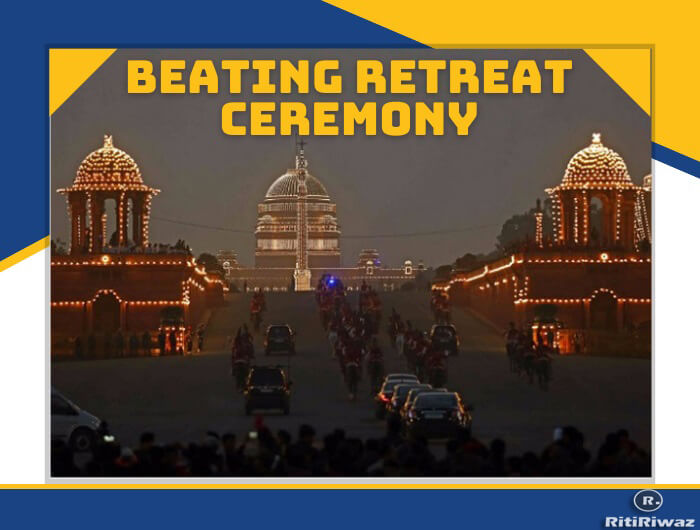Beating Retreat Ceremony Ends Republic Day Celebrations

Beating Retreat ceremony is held on January 29 every year at Vijay Chowk or the victory square, with the stately Rashtrapati Bhawan at the background and marks the formal conclusion of the Republic Day celebration. The Festival of Beating Retreat Ceremony is observed keeping in mind the age-old tradition, according to which, soldiers called a close down to the war at sunset.
Republic Day Celebration
Republic Day on January 26 marks an important event in Indian history. India got Independence on 15 August 1947, but at that time our constitution was not applicable and it was only on 26th January 1950 when our constitution came into force.
The Constituent Assembly of India abolished the Government of India Act 1935 and declared India a republic. India became a sovereign, democratic republic. The first President Dr. Rajendra Prasad took the oath of office in the Government House, the ceremony lasts for 3 days.
Every year to mark the date a grand parade is held at Rajpath. The parade that takes place on the occasion of Republic Day starts from Vijay Path and continues till India Gate, in which the Army Air Force and the Army salute the President. And shows bravery with her weapons. Republic Day is concluded by organizing the Beating Retreat at Vijay Chowk on 29 January. Three national days are celebrated in India, Independence Day, Republic Day, and Gandhi Jayanti, all three of them are declared national holidays.
In 2022 the Republic Day celebration begin on 23 January instead of 24 January to include Netaji Subhash Chandra Bose’s birth anniversary in the celebration. The celebration begins on January 23 will conclude on January 29 with the Beating Retreat Ceremony. The central government in 2021 has started the celebration of Subhas Chandra Bose’s birth anniversary as Parakram Diwas.
Beating Retreat Ceremony
Beating Retreat marks a centuries-old military tradition dating from the days when the troops ceased fighting, sheathed their arms withdrew from the battlefield, and returned to the camps at sunset at the sounding of the Retreat.
The military tradition began in the 17th century when King James II of England ordered his troops to beat drums, lower flags. Beating Retreat is organized warfare when the beating of drums and the parading of Post Guards heralded the closing of camp gates and the lowering of flags at the end of the day.
In India, the ceremony dates back to 1950 when Major Roberts of the Indian Army indigenously developed the unique ceremony of display by the massed bands.
The Beating Retreat ceremony follows the age-old tradition where the bands of the Indian Armed Forces will play various hymns in front of the President of India and other dignitaries. Defense forces who come to the capital as a part of Republic Day celebrations are sent back to their barracks by the President, which is what Beating Retreat Ceremony is all about.
Beating Retreat marks the end of the week-long festivities of republic day, which begin on January 23. The event is hosted at Vijay Chowk on the evening of 29th January and is performed by bands of the three wings of the military, the Indian Army, Indian Navy, and Indian Air Force. Ending the Beating the Retreat, the parade will march off towards Raisina Hill to ‘Saare Jahan Se Aacha’ composed by Mohd Iqbal, better known as Allama Iqbal.
The Centre recently has dropped Mahatma Gandhi’s favorite hymns Abide with me from the Beating Retreat ceremony as more Indian tunes will be played to mark Azadi ka Amrit Mahotsav, which celebrates the 75th year of India’s Independence.
A Scottish Anglican poet and hymnologist Henry Francis Lyte 1847 wrote Abide with me has been a part of the India Beating Retreat ceremony since 1950. The patriotic song Ae mere Watan ke logon will be included which was written by Kavi Pradeep. Kavi Pradeep wrote the song in 1962 after the Indo-China war. Composed by C. Ramchandra, the morale-boosting words provided solace to a nation agonized by defeat.
Ae mere watan ke logon literally meaning “Oh, the People of My Country” has a special place in Indian History. The song is revered next to the National Anthem and the National Song (Vande Mataram). A tribute to the war heroes and martyrs, its popularity remains to date. The patriotic song is played during all the major national celebrations and events. The song has a far wider connection with the people of India than Abide with me and is more appropriate to celebrate the valor and gallantry of the armed forces of India.
The ceremony is held on January 29 every year and marks the culmination of the five-day-long Republic Day celebrations.






